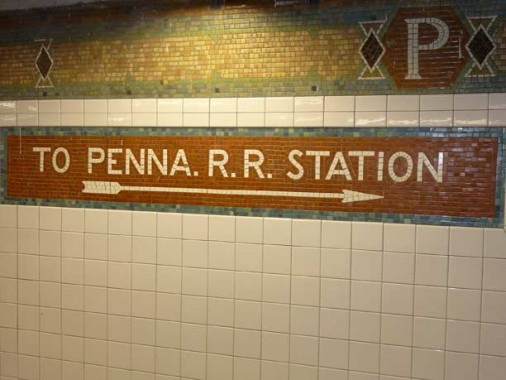Word came to my unbelieving ears that some younger viewers of the Grammy Awards ceremony in February 2012 were stumped when the sprightly figure of Paul McCartney appeared on their television screens. Never before had they been forced to deal with anyone quite this old, and never having heard of the Beatles or pop rock itself, were puzzled by this man and the music he was making.
It occurs to me that many younger New Yorkers, both natives and visitors, might be scratching their heads when seeing the 34th Street stations of both the IND and IRT marked with the word “Pennsylvania.” What state is this, anyway? Why is it “Pennsylvania” or “Penn” Station?
The name, of course, refers to the old Pennsylvania Railroad, founded in 1846 and headquartered in Philadelphia. Nicknamed the Pennsy, it was once the largest passenger railroad in the USA, serving the Middle Atlantic and Midwest states as far west as St. Louis, and the largest traded corporation in the world. It merged with its rival New York Central RR in 1968 to form Penn Central, but its decline was too steep to be prevented, and its assets were transferred to Conrail in 1976. The Pennsy was dead.
The Pennsylvania Railroad controlled the Long Island Rail Road from 1900-1949 and built a magnificent, palatial railroad station, Pennsylvania Station, in 1910. The original Penn Station lasted only 53 years before it became judged to be too costly to maintain, as rail traffic had declined steadily after World War II–its air rights were sold off and an office building and new Madison Square Garden were constructed in its place. Today, there is no Pennsylvania Station building; the terminal is merely the basement of the Penn Plaza complex. Plans are floated now and then to convert the James Farley Post Office Building for use as a train station, but the costs for this type of operation have skyrocketed in recent years.
The IRT station at 34th Street, built in 1917, and the IND station, which came along in 1933, are vestiges of the grandeur that was the old Penn. The IRT station in particular illustrates the great adherence to detail that once characterized our public works.
Side platform “Pennsylvania” nameplate (1917). Station tiling is mostly brown but different hues are parts of the highlighting. Both the IRT and IND stations were built to prevent cross-platform transfers. Planners believed such transfers would lead to crushing crowds, so they built the stations with two side platforms and two central platforms.* Today this makes for a difficult transfer and savvy commuters use the across the platform transfers at 14th or 42nd Streets if they want to switch from the local to the express, or the reverse.
*See correction by subway historian Andy Sparberg in Comments.
When the IRT station was completed in 1917 the subways’ chief station designer, or “art director,” was named Squire Vickers. A painter by trade, he built stations according to design movements of the day, one of which, Arts and Crafts, emphasized what looked to be a handmade, almost rustic, appearance, even though it was very precise and exact. Note how the surrounding mosaic pieces in the “O” and “P” outline the letters. A careful look at the border reveals 3 different shades of aqua blue/green. The mosaic tiling pieces were all hand cut.
http://www.youtube.com/watch?v=8KQurBSn6No
McKim, Mead and White, who built the original Penn Station in 1910, built the Pennsylvania Hotel across 7th Avenue in 1919, which is still standing today, though there are plans afoot to raze it and build a huge office tower in its place. Its phone number, Pennsylvania 6-5000, became a hit Big Band recording for Glenn Miller in 1940 (seen above in Jimmy Stewart’s Miller biopic) and today is the longest working phone number in NYC at over 80 years.
There are still vestiges of the Pennsylvania Railroad around, like this painted sign in a Penn Station passageway.
Keystones, the symbol of the Pennsy, were cut into this concrete overpass over Hillside Avenue in Richmond Hill, Queens.
Had to blow this one up a bit, hence the fuzziness. All steam engines on the Pennsylvania, like the retired Engine 35 at the LIRR Museum in Oyster Bay, sported a keystone-shaped nameplate on the nose.
2/13/12


